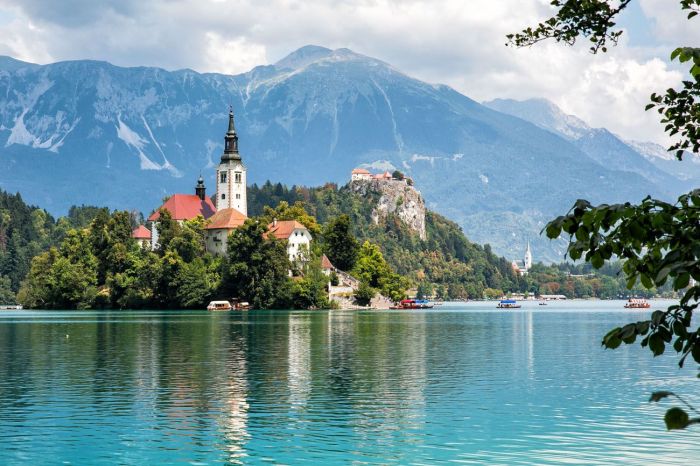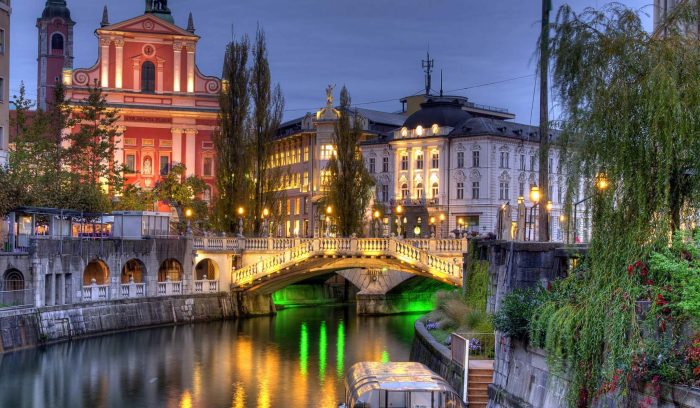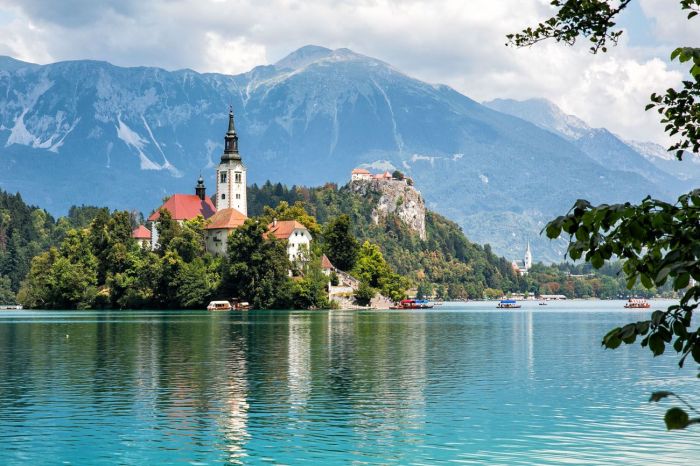Best places to visit in Slovenia – a captivating journey through a land of breathtaking natural beauty, rich history, and delectable cuisine. From soaring mountains to sparkling lakes, Slovenia offers something for every traveler. This guide will take you on a personalized exploration of the country’s must-see destinations, highlighting the best activities, and offering insights into planning your perfect trip.
This comprehensive guide delves into the heart of Slovenia, revealing its diverse offerings. We’ll uncover the secrets of its stunning landscapes, explore its historical landmarks, and savor its unique culinary traditions. Get ready to discover why Slovenia is a hidden gem waiting to be explored!
Introduction to Slovenia
Slovenia, a landlocked country nestled in the heart of Europe, boasts a captivating blend of natural beauty and rich cultural heritage. Bordered by Austria, Italy, Croatia, Hungary, and a sliver of the Adriatic Sea, this small nation packs a powerful punch of stunning landscapes, from the Julian Alps to the picturesque Soča Valley. Its history, shaped by various influences, has left an indelible mark on its traditions and architecture.
Slovenia’s unique position fosters a vibrant mix of experiences, promising a memorable journey for any visitor.Slovenia’s charm lies not only in its diverse scenery but also in its welcoming people and well-preserved cultural traditions. Its past as a crossroads of different empires, from the Roman Empire to the Habsburg Monarchy, has contributed to its distinctive cultural mosaic. From the medieval castles overlooking the valleys to the charming villages nestled amongst the hills, Slovenia invites you to step back in time while still embracing modern comforts.
Geographical Location and Defining Characteristics
Slovenia is situated in Central Europe, bordered by the Alps and the Dinaric Alps. Its topography is remarkably diverse, ranging from high mountain peaks to deep valleys and extensive karst landscapes. The country’s strategic location between the Alps and the Adriatic Sea has profoundly shaped its history and culture. The country’s size is relatively compact, facilitating easy exploration of its many regions and attractions.
Historical Context and Cultural Influences
Slovenia’s history is deeply intertwined with the empires that have controlled the region over the centuries. From the Romans to the Habsburgs, each period has left its imprint on the country’s architecture, traditions, and language. The region’s proximity to Italy and Austria has contributed to its unique blend of cultural influences, evident in its cuisine, architecture, and artistic expressions.
The country’s rich cultural heritage is visible in its historical sites, traditional crafts, and vibrant festivals.
Natural Beauty: Mountains, Lakes, and Forests
Slovenia is a paradise for nature lovers. The Julian Alps offer breathtaking vistas and opportunities for hiking, skiing, and mountaineering. Numerous picturesque lakes, such as Lake Bohinj and Lake Bled, are surrounded by lush forests and stunning mountain scenery. Slovenia’s extensive forest cover, home to diverse flora and fauna, contributes to the country’s pristine natural beauty. These natural resources are carefully managed to preserve their ecological integrity.
Unique Flora and Fauna
Slovenia’s diverse landscapes support a rich array of plant and animal life. The country’s alpine meadows, forests, and karst regions provide habitats for unique species. The Soča Valley, for example, is known for its impressive trout populations. Slovenia’s commitment to environmental protection has played a crucial role in preserving its unique biodiversity.
- The Triglav National Park, Slovenia’s largest national park, provides a haven for rare plant and animal species, showcasing the country’s commitment to conservation.
- The karst regions, with their unique geological formations, support a diverse array of flora and fauna, including cave-dwelling insects and reptiles.
Popular Tourist Destinations

Slovenia, a land of breathtaking natural beauty and rich cultural heritage, boasts a multitude of captivating destinations. From soaring mountains to sparkling lakes, the country offers experiences for every traveler. This section delves into the top five most popular tourist destinations, exploring their unique attractions and catering to diverse interests.
Top 5 Most Popular Tourist Destinations
Slovenia’s popularity stems from its diverse landscapes, offering a wide array of activities for various interests. From adventure seekers to those seeking relaxation, each destination caters to a specific demographic. The following destinations consistently top the list of popular tourist spots, attracting visitors from around the globe.
- Lake Bled: Nestled in the Julian Alps, Lake Bled is a picturesque destination famous for its stunning scenery. The lake’s iconic island church, surrounded by lush greenery, is a captivating sight. Activities such as boating, swimming, and hiking are abundant in the area, providing opportunities for both relaxation and exploration. The tranquil atmosphere and the romantic aura of the lake make it an ideal spot for couples and those seeking serenity.
The surrounding villages offer charming cafes and restaurants where visitors can enjoy local cuisine and soak in the ambiance.
- Ljubljana: Slovenia’s capital city, Ljubljana, offers a blend of historical charm and modern vibrancy. The Ljubljanica River winds through the city center, creating a picturesque backdrop. The Ljubljana Castle, offering panoramic views, is a must-see. Visitors can explore the city’s charming cobblestone streets, enjoy the lively atmosphere, and indulge in the city’s rich culinary scene. The city’s well-preserved historical architecture and the vibrant cultural scene provide a unique experience for travelers.
- Lake Bohinj: Another stunning alpine lake, Lake Bohinj, is situated in the heart of the Julian Alps. Boasting a magnificent mountain backdrop, the lake offers opportunities for hiking, boating, and fishing. The surrounding trails provide opportunities for breathtaking views and adventures in the nature.
- Postojna Cave: This renowned cave system is one of Slovenia’s most popular attractions. Visitors can take a guided tour through the vast underground caverns, marveling at the stalactites and stalagmites. The cave’s impressive formations and the fascinating geological history make it a unique and captivating experience. The tours are often accompanied by informative explanations about the cave’s development and the local flora and fauna.
- Triglav National Park: For adventure enthusiasts, Triglav National Park offers unparalleled hiking opportunities. The park’s rugged terrain and towering peaks provide breathtaking vistas. Hikers can embark on challenging trails, exploring the diverse landscapes. The park’s pristine environment, abundant wildlife, and varied terrains cater to various skill levels, from beginner hikers to experienced mountaineers.
Comparing the Appeal of Destinations
Different destinations appeal to different types of travelers. Lake Bled’s tranquility and picturesque charm attract relaxation seekers, while Triglav National Park’s challenging trails cater to adventure enthusiasts. Ljubljana offers a balance of cultural immersion and relaxation, appealing to a broad spectrum of travelers. Lake Bohinj and Postojna Cave cater to those interested in natural beauty and exploring underground wonders, respectively.
Comparison Table of Top 5 Destinations
| Name | Brief Description | Key Attractions |
|---|---|---|
| Lake Bled | Picturesque alpine lake with an island church | Lake, island church, hiking, boat rides |
| Ljubljana | Slovenia’s capital city with a blend of old and new | Ljubljana Castle, Ljubljanica River, historical architecture, cafes |
| Lake Bohinj | Stunning alpine lake in the Julian Alps | Lake, hiking, boating, fishing, surrounding mountains |
| Postojna Cave | Renowned cave system with impressive formations | Guided tours, stalactites, stalagmites, underground exploration |
| Triglav National Park | Rugged national park with challenging trails | Hiking, stunning views, varied landscapes, wildlife |
Accommodation Comparison
| Destination | Budget-Friendly Options | Luxury Options |
|---|---|---|
| Lake Bled | Hostels, guesthouses, budget-friendly hotels | Luxury hotels with lake views, boutique accommodations |
| Ljubljana | Guest houses, hostels, apartments | Boutique hotels, luxury hotels in the city center, apartments |
Nature and Outdoor Activities
Slovenia’s stunning natural beauty makes it a paradise for outdoor enthusiasts. From soaring peaks to crystal-clear lakes, the country offers a diverse range of hiking trails, challenging climbs, and tranquil waterways perfect for kayaking and cycling. Exploring these landscapes provides unparalleled opportunities to connect with nature and experience the country’s unique charm.
Slovenia boasts stunning natural beauty, from the Julian Alps to the picturesque coast. Thinking about a change of scenery? For those considering a retirement destination in the US, exploring the best places to retire in North Carolina could be a fantastic option best places to retire in north carolina. However, if you’re looking for a European escape, Slovenia still remains a top choice, with its charming villages and vibrant culture.
Hiking Trails
Slovenia boasts a network of well-maintained hiking trails, catering to various fitness levels. These trails offer breathtaking views of alpine meadows, lush forests, and picturesque valleys. Whether you’re an experienced hiker or a beginner, there’s a trail perfect for you. The varied terrain ensures that each journey is unique and rewarding.
- Triglav National Park Trails: This park, encompassing Slovenia’s highest peak, Triglav, provides a range of trails, from easy strolls to challenging climbs. The trails offer panoramic views of the surrounding valleys and mountains. The difficulty varies considerably, and some require significant experience and appropriate gear for the challenging ascents.
- Julian Alps Trails: The Julian Alps are known for their dramatic landscapes and well-marked trails. From gentle walks to demanding climbs, the region caters to all skill levels. Many trails traverse charming villages and offer opportunities to explore the local culture alongside the natural beauty.
- Soča Valley Trails: The Soča Valley, renowned for its turquoise river, provides a diverse range of hiking trails. Some trails follow the riverbanks, offering stunning views of the water, while others ascend into the surrounding hills, providing glimpses of alpine meadows and forests.
National Parks and Reserves
Slovenia’s national parks and reserves are crucial for protecting its diverse ecosystems and providing ample opportunities for outdoor exploration. Each park holds unique ecological features and caters to a range of interests.
- Triglav National Park: This park is a haven for wildlife and boasts a diverse range of habitats. The park protects a vast area, from alpine meadows to dense forests. Its trails allow visitors to observe diverse flora and fauna, offering a chance to experience the raw beauty of Slovenia.
- Škocjan Caves National Park: This UNESCO World Heritage site is famous for its impressive underground caves. The caves’ intricate formations and unique ecosystem are remarkable. Tours provide insights into the fascinating geological history and the region’s biodiversity.
- Soča Valley: The valley is known for its crystal-clear Soča River. The surrounding landscapes offer a range of outdoor activities, from hiking to kayaking. The region’s beauty is complemented by the diverse flora and fauna that thrive in the valley.
Outdoor Activities
Slovenia’s outdoor activities extend beyond hiking. Cycling, rock climbing, and kayaking offer exciting alternatives to explore the region’s diverse landscapes.
- Cycling: Slovenia’s rolling hills and picturesque countryside are ideal for cycling. From leisurely rides along the riverbanks to challenging mountain climbs, the options are plentiful. Well-maintained cycle paths crisscross the country, making it a haven for cyclists of all levels.
- Rock Climbing: Slovenia’s limestone cliffs offer excellent opportunities for rock climbing. The varied routes cater to different skill levels. Experienced climbers can explore challenging routes, while beginners can enjoy easier climbs. Climbing areas often provide stunning views of the surrounding landscape.
- Kayaking: Slovenia’s rivers, particularly the Soča, are ideal for kayaking. The clear waters and stunning scenery make it a memorable experience. Kayaking tours are available, offering guided trips and insights into the region’s natural beauty.
Best Times to Visit
The best time to visit Slovenia for outdoor activities depends on the specific activity.
Slovenia boasts stunning natural beauty, from its dramatic mountains to its picturesque lakes. While exploring the best spots in Slovenia, you might also consider the incredible Klahoose Wilderness Resort in British Columbia, Canada, which offers a unique connection with the indigenous first nations klahoose wilderness resort british columbia canada indigenous first nations. Ultimately, Slovenia offers a wealth of experiences for travelers, making it a top choice for a memorable trip.
- Hiking: Spring and autumn offer pleasant temperatures and fewer crowds, ideal for hiking. Summer brings warmer temperatures but also more tourists.
- Cycling: Spring and autumn are excellent for cycling due to pleasant temperatures. Summer can be hot, but some cyclists prefer the warmth.
- Rock Climbing: Summer provides ideal conditions for rock climbing, with warm temperatures and sunny days. However, the climbing season is typically extended due to favorable weather conditions.
- Kayaking: Spring and autumn are good for kayaking, with stable waters and fewer crowds. Summer is also a popular time to kayak, but the river can be warmer.
Hiking Trail Overview
| Name | Difficulty | Length (km) | Key Features |
|---|---|---|---|
| Triglav Round | Moderate to Difficult | 15-20 | Panoramic views, challenging ascent |
| Julian Alps Trail | Easy to Moderate | 8-12 | Scenic views, charming villages |
| Soča Valley Trail | Easy to Moderate | 5-10 | River views, forests, diverse landscape |
Culture and History
Slovenia’s rich tapestry of history and culture is woven into the very fabric of the nation. From ancient Roman settlements to medieval castles, the country boasts a captivating past that continues to influence its present. Exploring these historical sites and cultural events provides a deeper understanding of the Slovenian identity and its enduring spirit.Slovenia’s historical sites offer a window into the lives of its people throughout the ages.
The diverse cultural events and festivals showcase the country’s vibrant artistic and social traditions, while its architectural landmarks stand as testaments to the ingenuity and aesthetic sensibilities of past generations.
Historical Sites and Castles
Slovenia’s castles and historical sites are scattered throughout the country, each with a unique story to tell. These impressive structures offer glimpses into medieval life, military strategies, and the evolving political landscape. Exploring these sites provides a tangible connection to the country’s past.
- Predjama Castle: Perched dramatically on a cliff face, Predjama Castle is a fascinating example of medieval architecture and ingenuity. Its subterranean passages and strategic location highlight the castle’s importance as a defensive structure. The castle’s unique position made it difficult to attack, and its subterranean tunnels added another layer of security. This combination of impressive architecture and defensive strategies makes Predjama Castle a truly remarkable historical site.
- Ljubljana Castle: Dominating the Ljubljana skyline, Ljubljana Castle offers panoramic views of the city. Its historical significance stretches back to Roman times, with evidence of settlements and fortifications throughout the centuries. The castle’s various towers and courtyards have played a vital role in the city’s defense and development. The castle’s history is intricately intertwined with the city’s development, showcasing the ebb and flow of power and influence.
- Škocjan Caves: While not a castle, the Škocjan Caves are a UNESCO World Heritage site, highlighting the region’s natural beauty and its geological significance. The caves’ intricate formations and vast underground chambers showcase the power of nature over time. The caves’ geological history provides valuable insights into the region’s past, revealing how the landscape has changed and developed over millennia.
Cultural Events and Festivals
Slovenia is renowned for its vibrant cultural calendar. From traditional folk dances to contemporary art exhibitions, these events showcase the nation’s artistic talent and diverse heritage. Attending these events offers a unique opportunity to experience the heart of Slovenian culture.
- Ptuj Medieval Days: This annual festival transports visitors back in time to the medieval era. Visitors can witness costumed reenactments, traditional crafts, and food stalls, offering a captivating glimpse into medieval life.
- Ljubljana Festival: A prestigious international festival, the Ljubljana Festival showcases a wide range of performing arts, from classical music to contemporary theater. The festival’s diverse programming attracts a global audience, providing an opportunity to experience the highest standards in artistic performance.
- Lipica Lipizzaner Horse Show: A captivating display of equestrian artistry, the Lipica Lipizzaner Horse Show features the famed Lipizzaner stallions. The show showcases the breed’s graceful movements and remarkable training, providing a stunning visual spectacle.
Architectural Styles and Landmarks
Slovenia’s architecture reflects a blend of historical influences and regional variations. From the grand Baroque palaces to the quaint Alpine villages, the country’s architectural heritage is a testament to the ingenuity and aesthetic sensibility of its people. Exploring these landmarks provides a visual journey through time.
- Baroque churches and palaces: The Baroque architectural style is prominent in many Slovenian towns and cities, with ornate churches and stately palaces adorning the landscape. These structures often feature intricate details and rich embellishments.
- Traditional Alpine villages: The picturesque Alpine villages offer a glimpse into the country’s rural heritage. The homes, often made of wood and stone, showcase traditional building techniques.
Museums and Art Galleries
Slovenia’s museums and art galleries offer a diverse range of collections, from historical artifacts to contemporary art. These institutions provide insights into the country’s artistic heritage and the evolution of its cultural expression. Visiting these venues enriches the visitor’s experience.
- National Museum of Slovenia: The National Museum of Slovenia houses a vast collection of artifacts, covering everything from prehistoric finds to contemporary art. The museum’s extensive holdings provide a comprehensive overview of Slovenian history and culture.
- National Gallery of Slovenia: The National Gallery of Slovenia features a significant collection of Slovenian and international paintings, sculptures, and other art forms. The gallery’s diverse collection highlights the evolution of art throughout the ages.
Important Historical Sites
| Name | Location | Description |
|---|---|---|
| Predjama Castle | Near Predjama | A medieval castle built into a cliff face, famous for its underground passages. |
| Ljubljana Castle | Ljubljana | A medieval castle offering panoramic views of the city, with historical roots dating back to Roman times. |
| Škocjan Caves | Škocjan | A UNESCO World Heritage site with spectacular underground chambers and geological formations. |
Food and Drink Experiences: Best Places To Visit In Slovenia

Slovenia’s culinary scene is a delightful blend of traditional recipes passed down through generations and modern interpretations. From hearty mountain dishes to fresh coastal flavors, the food reflects the country’s diverse landscapes and rich history. The emphasis on local, seasonal ingredients creates a unique and flavorful experience for every visitor.Slovenian cuisine is deeply rooted in the use of fresh, locally sourced produce.
This commitment to quality ingredients, coupled with traditional cooking techniques, results in dishes that are both satisfying and authentic. The country’s strong wine-making tradition further enhances the overall dining experience.
Culinary Traditions and Specialties
Slovenian cuisine boasts a variety of dishes that showcase the country’s diverse regions. From the mountainous north to the Adriatic coast, each region has its own distinct culinary heritage. The use of fresh, seasonal ingredients is central to the tradition, with an emphasis on simplicity and natural flavors. Meat, especially pork and venison, are popular, often prepared with traditional herbs and spices.
Best Restaurants and Cafes in Different Regions
Several regions offer excellent dining experiences. In the Julian Alps, traditional restaurants offer hearty stews and local cheeses. The coastal regions feature fresh seafood, while the Ljubljana area boasts a vibrant culinary scene with a mix of traditional and modern establishments. Searching for local recommendations online can be very helpful in finding hidden gems and popular spots alike.
Local Wine-Making Process and Importance
Slovenia has a long and respected wine-making tradition. The country’s diverse microclimates create ideal conditions for cultivating a variety of grape varieties. The winemaking process typically involves careful selection of grapes, fermentation, and aging. Slovenian wines are known for their distinctive flavors and aromas, reflecting the unique terroir of the region. The country’s wine culture is an important part of its identity, contributing to both its economy and its tourism appeal.
Traditional Slovenian Drinks and their Cultural Significance
Traditional Slovenian drinks complement the culinary experience. Among them is the popular “žganci,” a traditional cornmeal porridge. This porridge is often served with local meats, making it a staple in many Slovenian homes. Other drinks like herbal infusions and fruit juices also play a significant role in the country’s cultural heritage, adding depth to the social and culinary traditions.
Regional Specialties
| Dish Name | Ingredients | Origin |
|---|---|---|
| Žeželj | Pork, sauerkraut, potatoes, and spices. | Gorenjska |
| Kremšnita | Savory or sweet pastry, often layered with custard or fruit. | Throughout Slovenia |
| Potica | Sweet pastry, often with nuts and dried fruits. | Throughout Slovenia |
| Štruklji | Filled pasta dough, often with cheese, potatoes, or fruit. | Throughout Slovenia |
| Riblja juha | Fish soup, with various fish and vegetables. | Coastal Regions |
Accommodation Options
Slovenia offers a diverse range of accommodation options to suit every budget and travel style. From cozy guesthouses to luxurious hotels, you’ll find something perfect for your Slovenian adventure. Choosing the right accommodation can significantly enhance your experience, allowing you to immerse yourself in the local culture and enjoy the breathtaking scenery.Finding the ideal accommodation depends on your preferences and travel companions.
Whether you’re seeking a budget-friendly stay, a comfortable mid-range option, or a luxurious experience, Slovenia has something for everyone. Understanding the advantages and disadvantages of different types of accommodation, and considering your travel style, can help you make an informed decision.
Types of Accommodation
Slovenia boasts a wide array of accommodation options, catering to various needs and preferences. These range from traditional guesthouses offering a taste of local hospitality to modern hotels providing all the comforts of home away from home. Apartments are also popular, offering more space and self-catering facilities.
Slovenia boasts stunning landscapes, from the Julian Alps to the picturesque coastal towns. Thinking about the incredible natural beauty of Slovenia, it’s easy to forget the potential dangers of travel. For instance, what would happen if you opened an airplane emergency door? Understanding these potential scenarios, like what would happen if you open airplane emergency door , is crucial for safe travel, and makes the breathtaking Slovenian experiences even more rewarding.
- Hotels: Hotels are a popular choice for travelers seeking a range of amenities, from swimming pools and spas to restaurants and meeting rooms. They are generally more expensive than other options but often offer a higher level of service and convenience.
- Apartments: Apartments provide more space and flexibility than hotels, allowing for self-catering and potentially greater privacy. They are a good choice for families or groups who want to cook their meals and spend more time together. This option can often be more budget-friendly than hotels.
- Guesthouses: Guesthouses provide a more intimate and personalized experience, often with a focus on local culture and hospitality. They offer a range of options in terms of amenities, from basic to more luxurious, often at a lower cost than hotels.
Budget-Friendly Options
Budget-friendly accommodations in Slovenia often include guesthouses and apartments in smaller towns. These options can provide a comfortable and affordable stay without sacrificing quality. For example, some guesthouses may offer simple rooms with shared bathrooms, making them an ideal choice for budget travelers. Look for accommodations with kitchen facilities if you’re on a tighter budget to prepare your own meals.
Mid-Range Accommodation
Mid-range accommodations provide a balance of comfort and value. Hotels in smaller towns and charming villages often fall into this category. They typically offer more amenities than budget-friendly options, such as private bathrooms and breakfast services. Many apartments in central locations, offering kitchenettes, can also be found in this category.
Luxury Accommodation
Luxury accommodations in Slovenia include high-end hotels and exclusive resorts, offering top-notch amenities and exceptional service. These hotels often feature gourmet restaurants, spas, and stunning views, catering to travelers seeking a truly exceptional experience. Some hotels are located in remote areas or in resorts near lakes or the coast, providing tranquility and privacy. Examples include boutique hotels and some larger hotels in major cities like Ljubljana or along the coast.
Best Areas for Different Travelers
The best areas for different travelers in Slovenia depend on their interests and preferences. For those interested in history and culture, Ljubljana, the capital, is an excellent choice. For outdoor enthusiasts, the Julian Alps and the Triglav National Park offer breathtaking hiking and climbing opportunities. The coastal regions, like Piran and Izola, are ideal for beach lovers and those seeking relaxation.
Accommodation Comparison Table
| Accommodation Type | Pros | Cons |
|---|---|---|
| Hotels | Wide range of amenities, convenience, often in central locations | Can be more expensive, less space, potentially less personalized |
| Apartments | More space, self-catering options, privacy, often more budget-friendly | Less service, need to arrange your own meals, might require more effort to find good ones |
| Guesthouses | Intimate experience, often local atmosphere, often budget-friendly, personalized service | May have fewer amenities, smaller rooms, less central location than some other options |
Practical Information
Planning your trip to Slovenia requires understanding the practical aspects, from transportation and visas to local customs and the best time to visit. This section provides essential details to ensure a smooth and enjoyable journey.
Getting Around
Slovenia offers a variety of transportation options to suit different needs and budgets. Efficient public transport, including trains and buses, connects major cities and towns, making it convenient for exploring the country at a relaxed pace. Renting a car provides greater flexibility, especially for reaching remote areas and national parks. Consider the distances and travel times when choosing your mode of transport.
For shorter distances, walking or cycling are excellent options, allowing you to experience the beauty of Slovenia at a slower pace.
Visa Requirements
Visa requirements for Slovenia depend on your nationality. Citizens of many European Union countries and other countries with visa-free agreements with the Schengen Area can travel to Slovenia without a visa for short stays. Check the official website of the Slovenian Ministry of the Interior for the most up-to-date information on visa policies and procedures. Be sure to carefully review the specifics of your nationality’s visa requirements.
Currency and Exchange Rates
The official currency of Slovenia is the Euro (€). Exchange rates fluctuate, so it’s advisable to check the current exchange rate before your trip to estimate the cost of activities and accommodations. ATMs are widely available throughout the country, allowing you to withdraw cash easily.
Local Customs and Etiquette
Slovenians are generally welcoming and friendly, but knowing a few basic local customs can enhance your interactions. Be mindful of common courtesies, such as using polite greetings and thanking individuals for their assistance. Respecting local traditions and customs will make your trip more enjoyable and contribute to a positive experience for everyone. Dress modestly when visiting religious sites.
Best Time to Visit
Slovenia’s pleasant weather and diverse activities make it an attractive destination year-round. Spring and autumn offer pleasant temperatures, while summer is ideal for outdoor activities. Winter brings opportunities for skiing and snowboarding in the mountainous regions. Consider the specific activities you plan to enjoy when selecting the best time to visit, and check for any local events or festivals happening during your desired travel period.
Key Practical Information Summary
| Category | Details |
|---|---|
| Currency | Euro (€) |
| Visa Requirements | Dependent on nationality; check official website for details. |
| Transportation | Trains, buses, cars, walking, cycling |
Illustrative Examples of Slovenian Scenery
Slovenia’s breathtaking landscapes are a testament to its diverse geography. From the towering peaks of the Julian Alps to the serene waters of its lakes, Slovenia offers a visual feast for the eyes. The country’s natural beauty is a significant draw for tourists, inspiring awe and wonder in all who visit.Slovenia’s varied landscapes are not just visually appealing; they also offer a wealth of opportunities for outdoor recreation and exploration.
The country’s rich biodiversity and historical significance are intertwined with its stunning natural settings, creating an unforgettable experience for visitors.
The Julian Alps: A Majestic Mountain Range
The Julian Alps, a stunning mountain range straddling the border between Slovenia, Italy, and Austria, are a captivating spectacle. Their jagged peaks pierce the sky, offering panoramic views that stretch far into the distance. These mountains are home to a rich tapestry of flora and fauna, adapting to the varied altitudes and microclimates.
- Flora: Alpine meadows with vibrant wildflowers, like edelweiss and gentians, blanket the higher elevations. Lower slopes are often covered with forests of coniferous trees, such as spruce and fir. The presence of diverse vegetation reflects the diverse conditions within the mountain range.
- Fauna: The Julian Alps are home to various wildlife, including chamois, marmots, and ibex, which are well-adapted to the rugged terrain. Birds of prey, such as eagles and vultures, soar above the peaks. The range’s altitude and varied landscapes support a rich variety of animal life.
Lake Bled: A Jewel of Slovenian Lakes
Lake Bled, nestled in the Julian Alps, is a picturesque lake famed for its beauty and tranquil atmosphere. The lake’s clear waters reflect the surrounding mountains, creating a stunning visual spectacle. Bled is known for its unique island with a church, and the surrounding area is dotted with charming villages and hiking trails.
- Activities: Visitors can enjoy boating, swimming, kayaking, or simply relaxing on the shores of the lake. The iconic Bled Castle, perched on a cliff above the lake, offers breathtaking views and historical significance.
- Scenic Beauty: The lake’s serene beauty is further enhanced by the surrounding forests and mountains. The tranquil atmosphere, coupled with the natural beauty, makes Lake Bled a popular destination for both domestic and international tourists.
The Triglav National Park Forests: A Vital Ecosystem
The forests within Triglav National Park are crucial to the region’s biodiversity. They provide habitats for numerous species of flora and fauna, supporting the ecological balance of the surrounding areas. The forests are also a vital part of Slovenia’s natural heritage.
- Ecological Significance: The forests regulate water flow, prevent soil erosion, and play a key role in maintaining the overall health of the ecosystem. The presence of various tree species, from pines to beech trees, further enriches the forest’s biodiversity and contributes to the overall beauty of the area.
- Importance for Tourism: The forests offer opportunities for hiking, nature walks, and exploring the local flora and fauna. The park’s well-maintained trails and facilities contribute to the experience of nature, attracting visitors who appreciate the serenity and beauty of the region.
A Typical Slovenian Village: A Glimpse into Rural Life, Best places to visit in slovenia
A typical Slovenian village often features traditional architecture, with houses built from local materials like stone or wood. These structures reflect the region’s history and cultural heritage. The villages are often nestled in valleys or on hillsides, with breathtaking views of the surrounding countryside.
- Community Spirit: The villages typically have a strong sense of community, with residents often involved in local events and activities. The close-knit atmosphere is a hallmark of Slovenian rural life, fostering a sense of belonging.
- Traditional Crafts: Local crafts and traditions are often preserved and practiced in these villages, showcasing the unique skills and artistry of the region’s people. The preservation of these traditions adds to the charm and authenticity of the village experience.
Tips for Planning a Trip
Slovenia, a land of breathtaking natural beauty and rich culture, is a perfect destination for a memorable getaway. Planning your trip effectively will ensure you make the most of your time and experience the best that Slovenia has to offer. Careful consideration of factors like the best time to visit, essential packing, and maximizing your limited time will elevate your journey.
Best Time to Visit
Slovenia’s pleasant weather makes it a year-round destination. However, the optimal time to visit depends on your preferences. Spring (April-May) and autumn (September-October) offer pleasant temperatures, fewer crowds, and vibrant landscapes. Summer (June-August) brings warmer temperatures and longer daylight hours, perfect for outdoor activities, but also attracts more tourists. Winter (November-March) offers a different charm, with snowy landscapes ideal for winter sports enthusiasts.
Essential Packing Tips
Packing light is key for a comfortable journey. Bring versatile clothing items that can be mixed and matched. Layers are crucial, as weather can change quickly, especially in mountainous regions. Comfortable walking shoes are essential for exploring the numerous hiking trails and charming towns. Don’t forget appropriate outerwear for potential chilly evenings or mornings.
Consider the activities you plan to undertake and pack accordingly.
Maximizing a Limited Time
Slovenia offers a wealth of experiences. To make the most of a limited time, prioritize your interests. If hiking is your passion, dedicate time to exploring national parks and trails. If culture is your focus, plan visits to historical sites and museums. Consider a combination of activities to ensure you cover diverse aspects of Slovenia.
Planning your itinerary in advance will help maximize your time.
Essential Items for a Trip
A well-prepared traveler has a head start. This list provides a starting point for your packing list.
- Passport and visa (if required): Essential documents for international travel. Verify the validity and necessary documentation required for your nationality and the Slovenian immigration rules.
- Travel insurance: Crucial for unforeseen circumstances, like medical emergencies or lost luggage. Review the details of your insurance policy to understand the coverage and exclusions.
- Comfortable walking shoes: Essential for exploring cities, towns, and hiking trails. Invest in sturdy, supportive footwear that is broken in before your trip.
- Reusable water bottle: Staying hydrated is crucial, especially during outdoor activities. A reusable bottle is environmentally friendly and cost-effective.
- Small first-aid kit: Include bandages, pain relievers, and any personal medications.
- Currency converter: Helpful for exchanging currency. Use a reliable online tool or mobile app to get an up-to-date conversion.
Illustrative Example of a Week-Long Itinerary
A week-long itinerary could include a mix of outdoor activities, cultural experiences, and food and drink adventures. For instance, days could be dedicated to exploring Ljubljana’s Castle, hiking in the Julian Alps, and sampling Slovenian cuisine. This example highlights how a balanced approach can yield a fulfilling trip.
Conclusive Thoughts
In conclusion, Slovenia’s beauty and variety make it a truly remarkable destination. From the adventurous hiker to the cultural enthusiast and the foodie, Slovenia has something to offer everyone. We hope this guide has inspired you to plan your own unforgettable Slovenian adventure. Prepare to be amazed by this captivating country!




